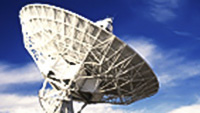Search and order online
Animation of dwarf galaxy colliding with the Milky Way
- Video Online only
- Title Animation of dwarf galaxy colliding with the Milky Way
- Released: 06/06/2024
- Length 00:00:31
- Language English
- Footage Type Animation
- Copyright Halo stars: ESA/Gaia/DPAC, T Donlon et al. 2024; Background Milky Way and Magellanic Clouds: Stefan Payne-Wardenaar
- Description
The Milky Way has grown over time as other galaxies have collided with and been consumed by our galaxy. Each collision triggered wrinkles that still ripple through different families of stars, affecting how they move and behave in space. ESA’s Gaia space telescope aims to unravel the history of our galaxy by studying these wrinkles – and new research from the mission now reveals that the most recent of these galactic collisions took place billions of years later than we thought.
This animation shows a merger beginning some 9.7 billion years ago and continuing to near-present day. It shows the spiral Milky Way in the centre of the frame, with our galaxy’s two prominent satellite galaxies (the Large and Small Magellanic Clouds) visible to the lower right.
A red cloud of stars is shown moving across the frame – this is a dwarf galaxy colliding with the Milky Way. This galaxy is shown being ripped apart as a result of the collision. At around 7 billion years ago, the animation increases in resolution to better show the ‘cloud’ of new stars that is drawn into the Milky Way from this colliding dwarf. These stars create a ‘halo’ of stars around our galaxy, a large starry component that extends outwards in all directions (this halo has been visually enhanced in this simulation, but in reality is very dim compared to the galactic disc). Shortly after the collision, the inner galaxy looks messy and wrinkly, but a long time after it becomes smooth.
Gaia is observing these wrinkles to trace and rewrite the history of the Milky Way. The space telescope is uniquely placed to explore the myriad stars in our skies, and has compiled an unrivalled dataset of the positions, distances and motions of around 1.5 billion stars to date. The new Gaia finding reveals that the wrinkles we see in the Milky Way were likely caused by a dwarf galaxy colliding with the Milky Way around 2.7 billion years ago – in other words, a large portion of the Milky Way only joined us within the last few billion years.


